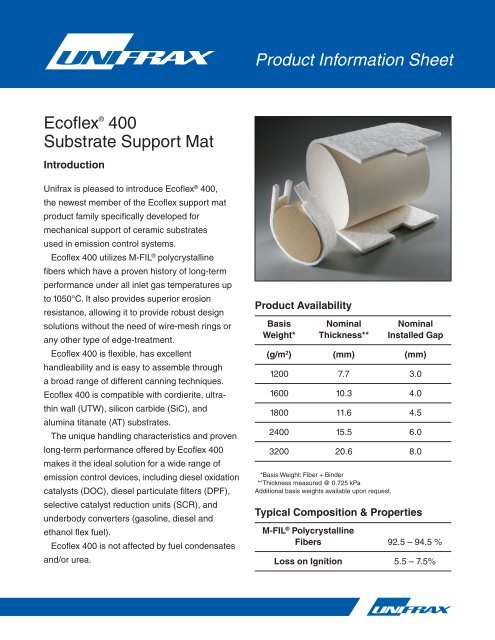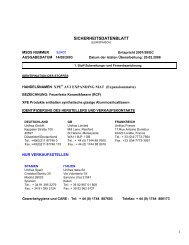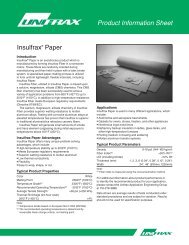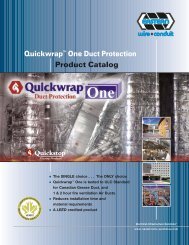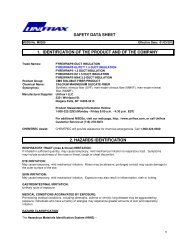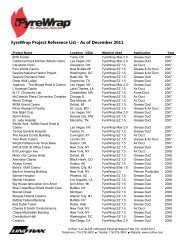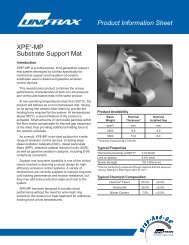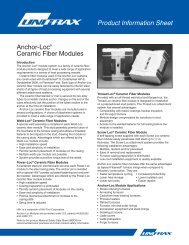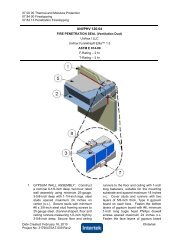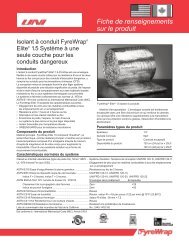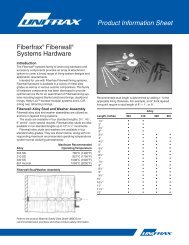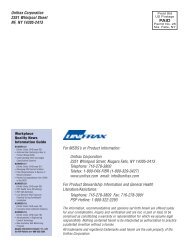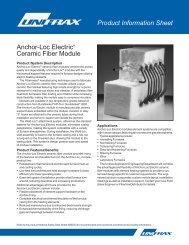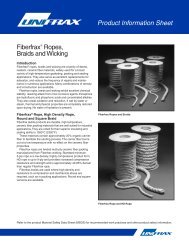Ecoflex® 400 Sustrate Support Mat (PDF) - Unifrax
Ecoflex® 400 Sustrate Support Mat (PDF) - Unifrax
Ecoflex® 400 Sustrate Support Mat (PDF) - Unifrax
Create successful ePaper yourself
Turn your PDF publications into a flip-book with our unique Google optimized e-Paper software.
Product Information Sheet<br />
Ecoflex ® <strong>400</strong><br />
Substrate <strong>Support</strong> <strong>Mat</strong><br />
Introduction<br />
<strong>Unifrax</strong> is pleased to introduce Ecoflex ® <strong>400</strong>,<br />
the newest member of the Ecoflex support mat<br />
product family specifically developed for<br />
mechanical support of ceramic substrates<br />
used in emission control systems.<br />
Ecoflex <strong>400</strong> utilizes M-FIL ® polycrystalline<br />
fibers which have a proven history of long-term<br />
performance under all inlet gas temperatures up<br />
to 1050°C. It also provides superior erosion<br />
resistance, allowing it to provide robust design<br />
solutions without the need of wire-mesh rings or<br />
any other type of edge-treatment.<br />
Ecoflex <strong>400</strong> is flexible, has excellent<br />
handleability and is easy to assemble through<br />
a broad range of different canning techniques.<br />
Ecoflex <strong>400</strong> is compatible with cordierite, ultrathin<br />
wall (UTW), silicon carbide (SiC), and<br />
alumina titanate (AT) substrates.<br />
The unique handling characteristics and proven<br />
long-term performance offered by Ecoflex <strong>400</strong><br />
makes it the ideal solution for a wide range of<br />
emission control devices, including diesel oxidation<br />
catalysts (DOC), diesel particulate filters (DPF),<br />
selective catalyst reduction units (SCR), and<br />
underbody converters (gasoline, diesel and<br />
ethanol flex fuel).<br />
Ecoflex <strong>400</strong> is not affected by fuel condensates<br />
and/or urea.<br />
Product Availability<br />
Basis Nominal Nominal<br />
Weight* Thickness** Installed Gap<br />
(g/m 2 ) (mm) (mm)<br />
1200 7.7 3.0<br />
1600 10.3 4.0<br />
1800 11.6 4.5<br />
2<strong>400</strong> 15.5 6.0<br />
3200 20.6 8.0<br />
*Basis Weight: Fiber + Binder<br />
**Thickness measured @ 0.725 kPa<br />
Additional basis weights available upon request.<br />
Typical Composition & Properties<br />
M-FIL ® Polycrystalline<br />
Fibers 92.5 – 94.5 %<br />
Loss on Ignition 5.5 – 7.5%
Canning Performance<br />
Ecoflex <strong>400</strong> is typically installed at a nominal gap bulk density (GBD) of 0.40 g/cm 3 . The room temperature<br />
compression behavior of Ecoflex <strong>400</strong> is shown in Figure 1. The GBD range for each specific application will be<br />
defined according to the requirements for holding force and substrate strength.<br />
Pressure [kPa]<br />
1<strong>400</strong><br />
1200<br />
1000<br />
800<br />
600<br />
<strong>400</strong><br />
Ecoflex <strong>400</strong> – Peak<br />
Ecoflex <strong>400</strong> – Residual<br />
Ecoflex 200FL – Peak<br />
Ecoflex 200FL – Residual<br />
Typical Cold Compression Curve<br />
Ecoflex <strong>400</strong> Substrate <strong>Support</strong> <strong>Mat</strong><br />
200<br />
0<br />
0.30 0.34 0.38 0.42 0.46 0.50<br />
GBD [g/cm 3 ]<br />
Figure 1: Typical Cold Compression Curve for Ecoflex <strong>400</strong> support mat.<br />
Erosion Resistance<br />
<strong>Support</strong> mat erosion may occur as a result of improper support mat installation or due to lack of holding force of<br />
the fiber matrix. Different types of support mat are more susceptible to erosion than others. Ecoflex <strong>400</strong> has been<br />
designed specifically to present a low erosion profile. Figure 2 presents comparative erosion resistance for different<br />
support mat types as a function of GBD.<br />
Volume Loss [cc]<br />
0.40<br />
0.35<br />
0.30<br />
0.25<br />
0.20<br />
0.15<br />
0.10<br />
0.05<br />
Comparative Erosion Performance<br />
Ecoflex <strong>400</strong> Substrate <strong>Support</strong> <strong>Mat</strong> vs. Exoflex 200FL Substrate <strong>Support</strong> <strong>Mat</strong><br />
Ecoflex <strong>400</strong><br />
Ecoflex 200FL<br />
0.00<br />
0.24 0.28 0.32 0.36 0.40<br />
GBD [g/cm 3 ]<br />
Figure 2: Comparative erosion data for Ecoflex <strong>400</strong> support mat.<br />
Form C-3139<br />
Effective 6/13<br />
© 2013, <strong>Unifrax</strong> I LLC<br />
All Rights Reserved<br />
Printed in USA<br />
Page 2 of 4
Friction Performance Data<br />
Friction between the mat and opposing surfaces has an influence on canning characteristics and long-term<br />
robustness in the converter. <strong>Unifrax</strong> measures the friction coefficient between the support mat and the shell at room<br />
temperature (important during canning) and also at different operating temperatures (which is important after the<br />
converter is under normal operating conditions). Figure 3 presents Ecoflex <strong>400</strong> performance at room temperature<br />
against stainless steel.<br />
Coefficient of Friction<br />
0.9<br />
0.8<br />
0.7<br />
0.6<br />
0.5<br />
0.4<br />
0.3<br />
0.2<br />
0.1<br />
Ecoflex <strong>400</strong><br />
Ecoflex 200FL<br />
Typical Friction Coefficients vs. Stainless Steel<br />
Typical Performance<br />
0<br />
0.20 0.25 0.30 0.35 0.40 0.45 0.50 0.55 0.60<br />
GBD [g/cm 3 ]<br />
Figure 3: Comparative cold friction data for Ecoflex <strong>400</strong> support mat.<br />
<strong>Support</strong> <strong>Mat</strong> Aging Performance<br />
Ecoflex <strong>400</strong> is designed to provide robust performance over a broad range of operating conditions. It is especially<br />
adapted to provide superior performance in high gap expansion conditions that may be common in heavy-duty<br />
diesel applications. Figure 4 presents typical aged mat performance for Ecoflex <strong>400</strong> and shows its advantages.<br />
Factors such as design gap and operating temperature also influence support mat performance. Please contact our<br />
Application Engineering Department for additional information regarding the performance of Ecoflex <strong>400</strong> under<br />
specific operating conditions.<br />
Aged <strong>Mat</strong> Pressure (kPa)<br />
100<br />
80<br />
60<br />
40<br />
20<br />
0<br />
Ecoflex <strong>400</strong><br />
Ecoflex 200FL<br />
Aged <strong>Mat</strong> Pressure at 600°C / 12% RGE<br />
Isothermal<br />
0.30 0.45 0.60<br />
GFD [g/cm 3 ]<br />
Figure 4: Ecoflex <strong>400</strong> support mat aging test as a function of temperature.<br />
Form C-3139<br />
Effective 6/13<br />
© 2013, <strong>Unifrax</strong> I LLC<br />
All Rights Reserved<br />
Printed in USA<br />
Page 3 of 4
Worldwide Technical <strong>Support</strong><br />
<strong>Unifrax</strong> is a worldwide sales and service organization with several international locations and representatives.<br />
The services that we provide include thermal modeling, system design engineering assistance, and failure<br />
analysis as well as technical exchange programs. For additional information regarding Ecoflex <strong>400</strong> or any of<br />
our catalytic support mats, please contact the <strong>Unifrax</strong> Emission Control Application Engineering Department<br />
at aecoordinator@unifrax.com.<br />
Data are average results of tests conducted under standard<br />
procedures and are subject to variation. Results should not<br />
be used for specification purposes.<br />
Refer to the product Safety Data Sheet (SDS) for<br />
recommended work practices and other product safety<br />
information.<br />
Form C-3139<br />
Effective 6/13<br />
© 2013, <strong>Unifrax</strong> I LLC<br />
All Rights Reserved<br />
Printed in USA<br />
Page 4 of 4<br />
The following are registered trademarks of <strong>Unifrax</strong> I LLC: Ecoflex and M-FIL.<br />
The test data shown are average results of tests conducted under standard procedures and are subject to variation. Results should not be<br />
used for specification purposes.<br />
Product Information Sheets are periodically updated by <strong>Unifrax</strong>. Before relying on any data or other information in this Product Information<br />
Sheet, you should confirm that it is still current and has not been superseded. A Product Information Sheet that has been superseded may<br />
contain incorrect, obsolete and/or irrelevant data and other information.<br />
<strong>Unifrax</strong> I LLC<br />
Corporate Headquarters<br />
600 Riverwalk Parkway, Suite 120<br />
Tonawanda, New York 14150<br />
Telephone: 716-768-6500<br />
Telefax: 716-768-6<strong>400</strong><br />
Internet: www.unifrax.com<br />
Email: info@unifrax.com


